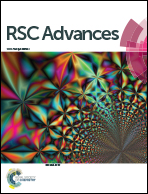Friedel–Crafts alkylation of heteroarenes and arenes with indolyl alcohols for construction of 3,3-disubstituted oxindoles†
Abstract
An intriguing camphorsulfonic acid catalyzed Friedel–Crafts alkylation of heteroarenes and arenes with indolyl alcohols has been developed featuring mild reaction conditions, wide substrate scope and high yields. This reaction provides an efficient method to access biologically important heterocyclic oxindole derivatives.


 Please wait while we load your content...
Please wait while we load your content...